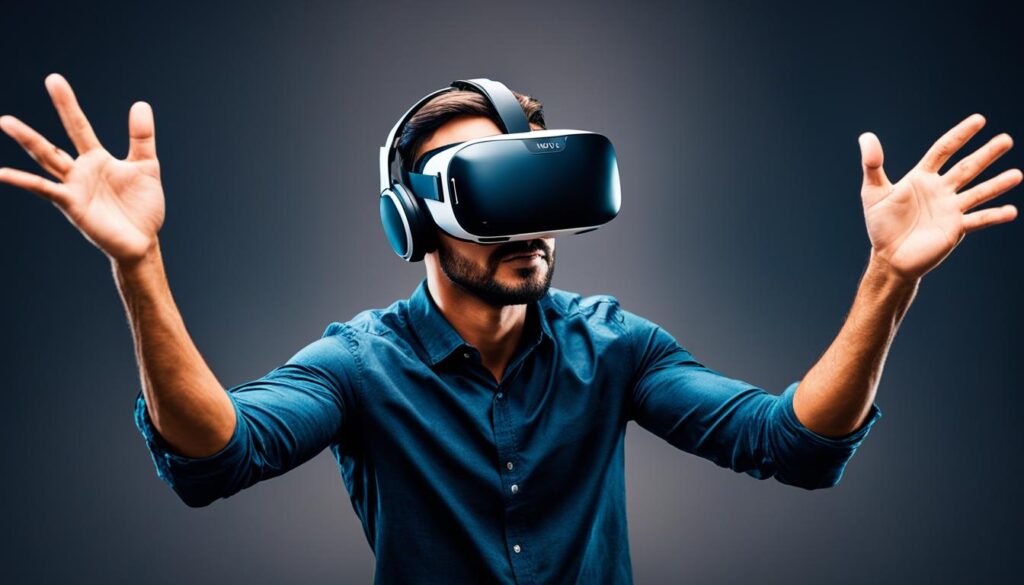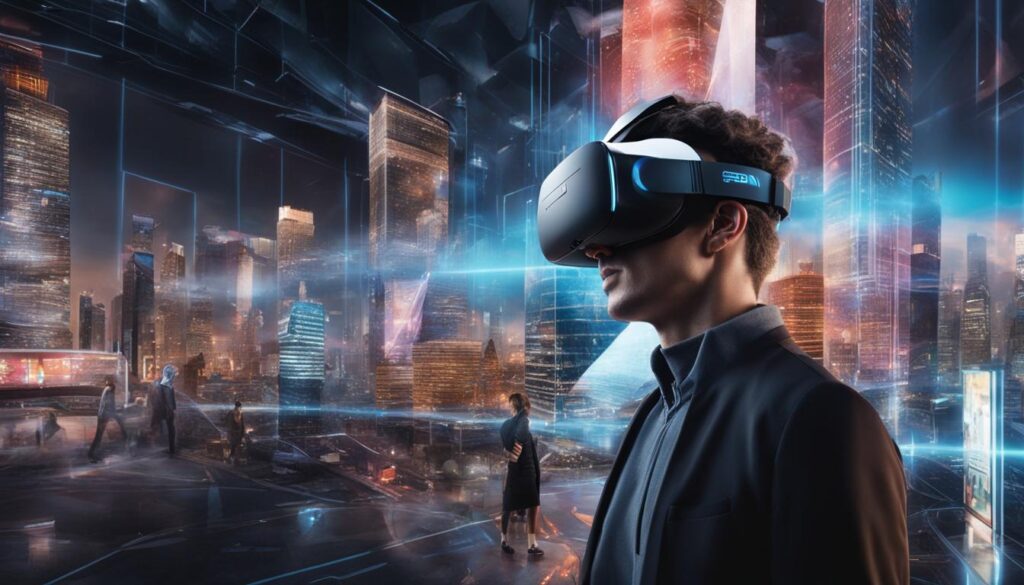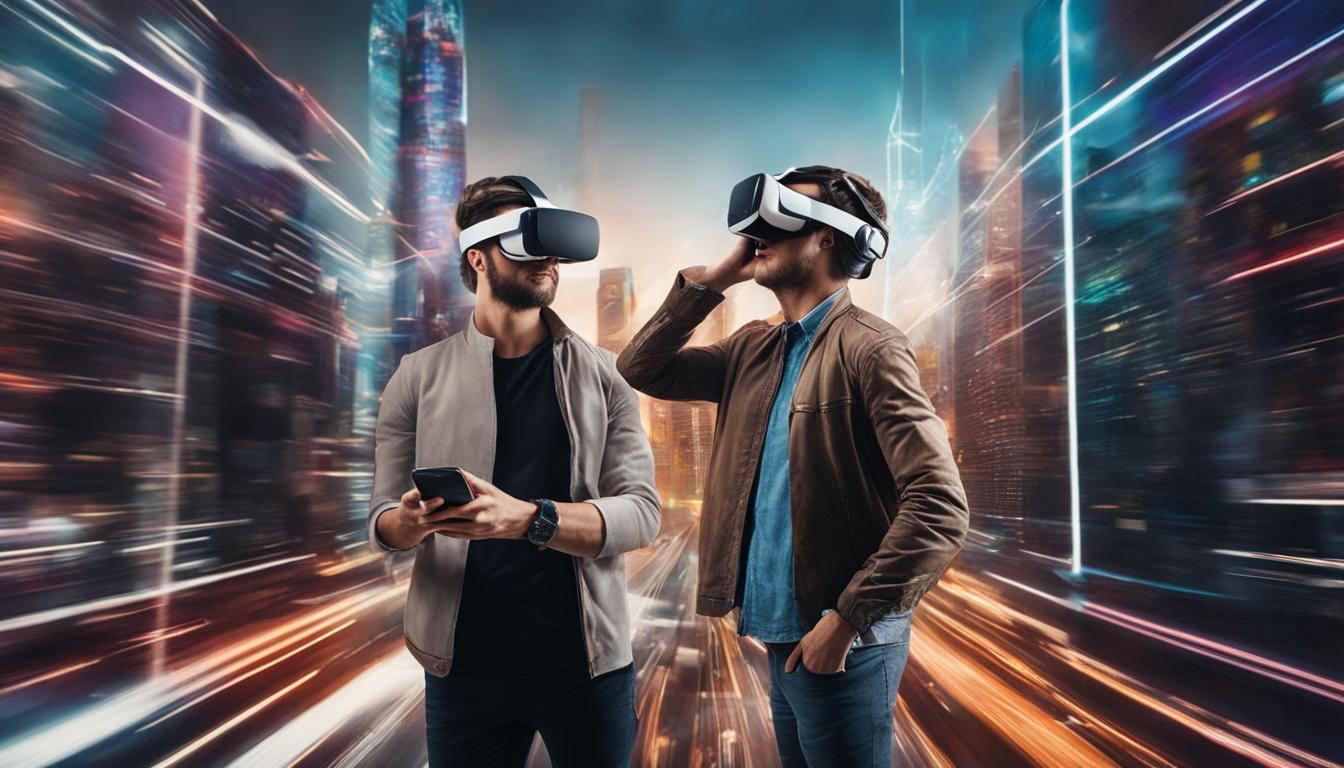Welcome to the exciting world of virtual reality (VR) and augmented reality (AR)! These two immersive technologies have taken the digital world by storm, offering unforgettable experiences and blurring the line between what’s real and what’s virtual. While they may seem similar, there are crucial differences that set them apart.
First, let’s address the question on everyone’s mind: what is the primary difference between virtual reality and augmented reality? In a nutshell, VR transports you to a completely virtual environment, while AR overlays virtual elements onto the real world. It’s like stepping into a new reality versus enriching your current reality with extra layers.
When comparing virtual reality and augmented reality, it’s essential to understand their distinctive features. VR relies on specialized equipment such as headsets and sensors to create a fully immersive experience. Users are fully immersed in a digital environment and interact with the virtual world through their senses.
On the other hand, AR is accessible through everyday devices like smartphones, making it more accessible to a broader audience. AR enhances the real world by overlaying virtual objects, text, or information onto the user’s view, allowing them to interact with both the virtual and real-world elements simultaneously.
While both VR and AR provide enhanced visuals and an immersive experience, their nature and applications differ significantly. VR is widely used in gaming, entertainment, and training, where users can explore virtual worlds and scenarios. AR, on the other hand, has a wide range of applications from gaming and marketing to translation and education, enriching various industries with innovative and interactive experiences.
Now that we’ve explored the distinctions between VR and AR, let’s delve deeper into each technology, uncovering their unique characteristics, advantages, and limitations.
Contents
- 1 Understanding Augmented Reality (AR)
- 2 Exploring Virtual Reality (VR)
- 3 Key Differences Between VR and AR
- 4 Advantages of AR and VR
- 5 Limitations of AR and VR
- 6 Conclusion
- 7 FAQ
- 7.1 What is the primary difference between virtual and augmented reality?
- 7.2 How do virtual reality and augmented reality work?
- 7.3 What are some applications of augmented reality?
- 7.4 What are some applications of virtual reality?
- 7.5 How do virtual reality and augmented reality devices differ?
- 7.6 What are the advantages of augmented reality?
- 7.7 What are the advantages of virtual reality?
- 7.8 What are some limitations of augmented reality?
- 7.9 What are some limitations of virtual reality?
- 7.10 What is the future of virtual reality and augmented reality?
- 7.11 Conclusion
- 8 Source Links
Key Takeaways:
- Virtual reality (VR) creates a fully immersive virtual environment, while augmented reality (AR) enhances the real world with virtual elements.
- VR requires specialized equipment, such as headsets, while AR can be experienced through smartphones.
- VR is widely used in gaming, entertainment, and training, while AR finds applications in gaming, marketing, translation, education, and more.
- VR provides a sense of presence, transporting users to fictional realities, while AR allows users to interact with virtual objects while remaining connected to their real-life surroundings.
- Both VR and AR have unique advantages and limitations that make them valuable in different contexts.
Understanding Augmented Reality (AR)
Augmented reality (AR) is an exciting technology that overlays virtual images and information onto the real world, enhancing our perception and interaction with the environment. Unlike virtual reality, which creates entirely computer-generated simulations, AR blends virtual elements with real-life surroundings.
AR can be experienced through smartphones or dedicated AR devices, providing users with a unique and immersive digital overlay. This technology allows you to visualize and interact with virtual objects while remaining connected to your real-life surroundings.
AR has a wide range of exciting applications across various industries. In gaming, AR provides captivating experiences that blend the virtual and physical worlds, allowing players to engage with virtual characters and objects in their real environment. AR is also being utilized in marketing campaigns to create interactive and memorable brand experiences for consumers.
One of the key advantages of AR lies in its potential for educational purposes. With AR, students can visualize complex concepts and gain a deeper understanding of subjects through interactive visualizations and simulations. In addition, AR has proven to be valuable in translation, where it can overlay real-time translations onto signs or text, making it easier for travelers to communicate in foreign countries.
Overall, augmented reality technology offers endless possibilities for enhancing our daily lives and transforming various industries. Its ability to seamlessly blend the virtual and physical worlds opens up a world of innovation and exploration.
Exploring Virtual Reality (VR)
Virtual reality (VR) is an immersive technology that transports you into a completely computer-generated simulation of an alternate world. It offers a unique and interactive experience that allows you to explore and interact with a fictional reality.
To experience VR, users require specialized equipment, such as headsets, sensors, and gloves. These devices work together to track your movements and replicate them within the virtual environment, creating a sense of presence.
The VR headset, worn over your eyes, displays high-resolution images and videos that mimic real-world scenarios or take you to imaginative realms. The sensors capture your movements, allowing you to navigate and interact with the virtual world as if it were real.
VR technology has come a long way in recent years, offering more realistic visuals, enhanced audio, and improved haptic feedback. These advancements contribute to a more immersive and engaging experience for users.
VR finds applications in various fields, including:
- Gaming: VR gaming provides an unparalleled level of immersion and interactivity, transporting players directly into the game world.
- Entertainment: VR enhances movie-watching experiences by placing you in the middle of the action, allowing you to be a part of the story.
- Training and Education: VR simulations offer realistic environments for training purposes, enabling hands-on learning experiences in fields such as medicine, engineering, and aviation.
- Architecture and Design: Virtual reality allows architects and designers to create virtual walkthroughs of their projects, giving clients a realistic preview of the final product.
| Virtual Reality (VR) | Applications |
|---|---|
| Gaming | Immersive gaming experiences |
| Entertainment | Enhanced movie-watching experiences |
| Training and Education | Realistic simulations for hands-on learning |
| Architecture and Design | Virtual walkthroughs and previews |
VR technology continues to evolve, bringing new possibilities and applications to various industries. As advancements continue to push the boundaries of what is possible, we can expect even more engaging and immersive virtual reality experiences in the future.

Key Differences Between VR and AR
When comparing virtual reality (VR) and augmented reality (AR), it becomes evident that both offer unique experiences with distinct differences. Understanding these differences can help you choose the technology that best suits your needs.
1. Devices Required
One of the main contrasting factors between VR and AR is the devices required to access the experiences. AR can be accessed through smartphones or tablets, making it easily accessible to a wide range of users. On the other hand, VR requires specialized headsets that immerse users in a fully virtual environment. These headsets often come with additional accessories such as sensors and gloves to enhance the VR experience.
2. Nature of the Experience
The nature of the experience is another key differentiator between VR and AR. AR enhances the real world by overlaying virtual elements onto it. This allows users to interact with virtual objects while remaining connected to their surroundings. In contrast, VR creates a completely virtual environment that immerses users in a fictional reality. VR experiences typically involve interacting with the virtual environment and objects within it.
To summarize, AR enhances the real world with virtual elements and can be accessed through smartphones, while VR creates a fully virtual environment that requires specialized headsets for immersion and interaction.
| Virtual Reality (VR) | Augmented Reality (AR) |
|---|---|
| Requires specialized headsets | Accessed through smartphones |
| Creates a fully virtual environment | Enhances the real world with virtual elements |
| Immerses users in a fictional reality | Allows users to maintain a connection with the real world |
As technology continues to advance, both VR and AR have the potential to shape various industries, from entertainment and gaming to education and training. Understanding their contrasting features can help you make informed decisions when considering which technology to utilize.

| Predicted Growth | Career Opportunities | Market Integration |
|---|---|---|
| Projected to reach $209.2 billion by 2022 | Software engineering, project management, graphic design, UX design, and more | Integration into diverse sectors such as gaming, education, healthcare, and retail |
| Seize the opportunity to be part of an industry that is set to revolutionize various sectors and create innovative experiences. | Unlock your potential and pursue a rewarding career in the rapidly growing VR and AR field. | Experience the seamless integration of VR and AR technologies into everyday life. |
Advantages of AR and VR
Both augmented reality (AR) and virtual reality (VR) offer unique advantages that contribute to their growing popularity. Let’s explore the benefits of each technology.
Advantages of Augmented Reality (AR)
AR has become increasingly prevalent in various fields due to its numerous advantages. Here are some key benefits of AR:
- Individualized learning: AR provides personalized learning experiences by tailoring information and content based on each user’s needs. This enables learners to engage with educational materials at their own pace and in a way that suits their learning style.
- Enhanced innovation: AR technology fosters creativity and innovation by allowing designers, engineers, and inventors to visualize and interact with virtual 3D models and prototypes. This facilitates the exploration of ideas, leading to the development of novel concepts and solutions.
- Increased accuracy: With AR, professionals in fields such as medicine, engineering, and architecture can overlay digital information onto real-world objects, improving accuracy and minimizing errors. This feature enhances precision and efficiency in complex tasks.
- Wide range of applications: AR has applications across various industries, including gaming, healthcare, marketing, retail, and more. From interactive gaming experiences to virtual try-on features in online shopping, AR technology continues to redefine how we interact with the world around us.
Advantages of Virtual Reality (VR)
VR offers a different set of advantages, providing users with immersive experiences in simulated environments. Let’s explore the benefits of VR:
- Immersive learning experiences: VR enables learners to be fully immersed in virtual environments, creating engaging and interactive educational experiences. This enhances knowledge retention and comprehension, making it an effective tool for training and education.
- Interactive environments: VR allows users to actively engage with virtual objects and environments, providing a hands-on experience. This interactivity promotes exploration, experimentation, and problem-solving skills.
- Increased work capabilities: VR technology can enhance productivity and efficiency in various industries. For example, architects and designers can visually walk through virtual buildings, allowing them to identify design flaws and make real-time modifications.
- Convenience: VR offers the convenience of accessing experiences and environments that may not be possible in the physical world. Whether it’s exploring far-off destinations, attending virtual conferences, or collaborating remotely with colleagues, VR transcends geographical limitations.
AR and VR each bring their own distinct advantages, making them valuable technologies in different contexts. By harnessing these advantages, we can leverage the full potential of AR and VR in education, gaming, healthcare, design, and numerous other industries.
Limitations of AR and VR
While augmented reality (AR) and virtual reality (VR) have their advantages, it’s important to acknowledge their limitations. Understanding these drawbacks can help in making informed decisions about implementing these technologies.
Disadvantages of Augmented Reality (AR)
- Expensive implementation: AR technology can be costly to develop and integrate into existing systems.
- Privacy concerns: AR applications may involve collecting and processing personal data, raising privacy concerns.
- Performance limitations: AR experiences heavily rely on device capabilities, and the quality may vary based on the hardware used.
- Potential impact on mental health: Extended use of AR devices may lead to eye strain, fatigue, and cognitive overload.
Drawbacks of Virtual Reality (VR)
- Escapism: Some individuals may become overly immersed in virtual reality experiences and neglect real-world responsibilities.
- Limited replication of real-world training: Although VR simulations can provide valuable training experiences, they may not fully replicate complex real-world scenarios.
| Augmented Reality (AR) | Virtual Reality (VR) | |
|---|---|---|
| Cost | Expensive | Relatively costly |
| Privacy | Concerns over data collection and privacy | Lower privacy concerns |
| Performance | Varying performance based on device capabilities | Relies on high-performance hardware |
| Mental Health | Potential impact on eye strain and cognitive overload | Risk of excessive escapism |
| Training Replication | N/A | May not fully replicate complex real-world scenarios |
It’s important to consider these limitations when implementing AR and VR technologies to ensure their effective and responsible use.

Conclusion
In conclusion, virtual reality (VR) and augmented reality (AR) offer unique experiences and opportunities in various industries. VR immerses users in fully virtual environments, allowing them to explore and interact with computer-generated worlds. On the other hand, AR enhances the real world by overlaying virtual elements onto it, creating a blended reality.
Both VR and AR have their advantages in terms of entertainment, education, marketing, and more. VR provides unparalleled immersion and can transport users to new and exciting places, while AR offers the ability to interact with virtual objects while remaining connected to the real world.
As technology continues to advance, VR and AR are expected to revolutionize numerous industries. From gaming and training simulations to medical advancements and architectural design, these technologies have the potential to reshape the way we live, work, and play.
In conclusion, embracing and understanding the differences and advantages of virtual reality and augmented reality will unlock the full potential of these technologies, offering new and innovative ways to engage with the digital world and create transformative experiences in various fields.
FAQ
What is the primary difference between virtual and augmented reality?
Virtual reality (VR) creates a completely computer-generated simulation of an alternate world, while augmented reality (AR) overlays virtual images and information onto the real world.
How do virtual reality and augmented reality work?
Virtual reality immerses users in a virtual environment with specialized equipment like headsets, sensors, and gloves. Augmented reality can be experienced through smartphones or dedicated AR devices, overlaying virtual elements onto the real world.
What are some applications of augmented reality?
Augmented reality has a wide range of applications, including gaming, marketing, translation, education, and more.
What are some applications of virtual reality?
Virtual reality is widely used in gaming, entertainment, training, and other fields where users can interact with a fully computer-generated environment.
How do virtual reality and augmented reality devices differ?
Augmented reality can be accessed through smartphones or dedicated AR devices, while virtual reality requires specialized headsets, sensors, and gloves.
What are the advantages of augmented reality?
Augmented reality offers individualized learning, enhances innovation, increases accuracy, and has a wide range of applications in various fields.
What are the advantages of virtual reality?
Virtual reality provides immersive learning experiences, creates interactive environments, increases work capabilities, and offers convenience.
What are some limitations of augmented reality?
Augmented reality can be expensive to implement, has privacy concerns, and may have performance limitations that need to be considered.
What are some limitations of virtual reality?
Virtual reality can lead to escapism and may not fully replicate real-world training, among other limitations.
What is the future of virtual reality and augmented reality?
The VR and AR industries are expected to grow significantly, offering career opportunities in software engineering, project management, graphic design, and more.
Conclusion
Virtual reality and augmented reality are distinct technologies with their own unique features and applications. Understanding the differences and advantages of each technology allows us to harness their potential in various industries and fields.




